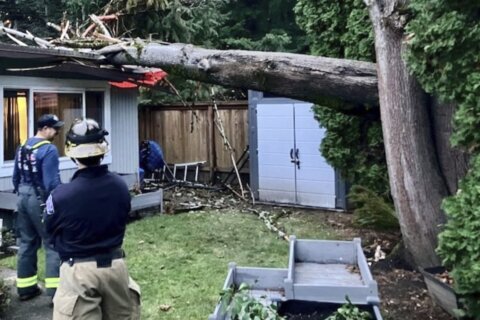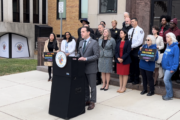FOREST RANCH, Calif. (AP) — Thousands of firefighters battling a wildfire in Northern California received some help from the weather hours after it exploded in size, scorching an area greater than the size of Los Angeles. The blaze was one of several tearing through the western United States and Canada, fueled by wind and heat.
Cooler temperatures and an increase in humidity could help slow the Park Fire, the largest this year in California. Its intensity and dramatic spread led fire officials to make unwelcome comparisons to the monstrous Camp Fire, which burned out of control in nearby Paradise in 2018, killing 85 people and torching 11,000 homes.
Paradise again was near the danger zone on Saturday. The entire town was under an evacuation warning, one of several communities in Butte County. Evacuation orders were also issued in Plumas, Tehama and Shasta counties. An evacuation warning calls for people to prepare to leave and await instructions, while an evacuation order means to leave immediately.
Temperatures are expected to be cooler than average through the middle of next week, but “that doesn’t mean that fires that are existing will go away,” said Marc Chenard, a meteorologist at the National Weather Service Weather Prediction Center in College Park, Maryland.
As of Saturday night, the Park Fire had scorched 547 square miles (1,416 square kilometers) and destroyed 134 structures since igniting Wednesday, when authorities said a man pushed a burning car into a gully in Chico and then fled. It was 10% contained and moving to the north and east near Chico.
The fire is larger than the city of Los Angeles, which covers about 469 square miles (1,214 square kilometers), and now ranks seventh on the list of the state’s top 10 largest wildfires by acreage, Cal Fire said in a social media post.
Nearly 2,500 firefighters were battling the blaze, aided by 16 helicopters and numerous air tankers.
Jeremy Pierce, a Cal Fire operations section chief, said firefighters were taking advantage of the cooler weather while it lasts: “We’re having great success today.”
Susan Singleton and her husband packed their SUV with clothes, some food and their seven dogs and rushed to evacuate their home this week in Cohasset, a town of about 400 northeast of Chico. They have since learned that their house burned down.
“Everything else we had burned up, but getting them out, getting us out, was my priority,” Singleton said Saturday, standing outside her SUV as her dogs rested. They have all been sleeping in the car outside a Red Cross shelter at a church that does not allow animals, and Singleton, 59, said the next thing is to find a place for her pets to stretch out.
“We’ve got to have a place to land and stop doing this, because this is what’s stressing me out,” she said.
Overall more than 110 active fires covering 2,800 square miles (7,250 square kilometers) were burning in the U.S. as of Friday, according to the National Interagency Fire Center.
In Southern California, a blaze in the Sequoia National Forest swept through the community of Havilah after burning more than 48 square miles (124 square kilometers) in less than three days. The town of 250 people had been under an evacuation order.
Crews were also making progress on a complex of fires in the Plumas National Forest near the California-Nevada line, Forest Service spokesperson Adrienne Freeman said. Traffic was backed up for miles near the border along the main highway linking Los Angeles and Las Vegas.
The most damage so far has been to the Canadian Rockies’ Jasper National Park, where 25,000 people were forced to flee and the park’s namesake, a World Heritage site, was devastated, with 358 of the town’s 1,113 structures destroyed.
Late Friday in eastern Washington, crews stopped the progress of a fire near Tyler that destroyed three homes and five outbuildings, the Washington Department of Natural Resources said.
Two fires in eastern Oregon, the Durkee and Cow Valley blazes, burned about 660 square miles (1,709 square kilometers).
And in Idaho, homes, outbuildings and a commercial building were among structures lost in several communities including Juliaetta, which was evacuated Thursday. The grouping of blazes referred to as the Gwen Fire was estimated at 41 square miles (106 square kilometers) in size with no containment.
___
Garcia reported from Chico, California, and Rodriguez from San Francisco. Associated Press writers Becky Bohrer, John Antczak, Rio Yamat, David Sharp, Holly Ramer, Sarah Brumfield, Claire Rush, Terry Chea, Scott Sonner, Martha Bellisle and Amy Hanson contributed.
Copyright © 2024 The Associated Press. All rights reserved. This material may not be published, broadcast, written or redistributed.







